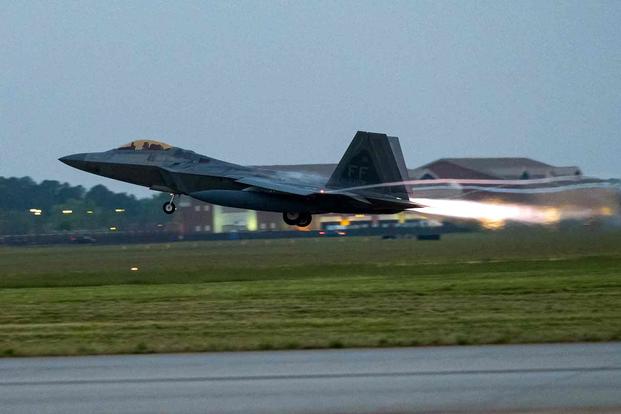
The Air Force is deploying F-22 Raptors to U.S. Central Command’s area of responsibility — ranging from the Middle East to central and south Asia — as Russian continues to provoke American jets as well as allies and partners in the area.
Deployment of the F-22s from the 94th Fighter Squadron out of Langley Air Force Base in Virginia was announced in a Central Command press release Wednesday. Officials said it is in direct response to “increasingly unsafe and unprofessional behavior by Russian aircraft” in the area. The number of F-22s being sent to the region was not announced.
“Russian Forces’ unsafe and unprofessional behavior is not what we expect from a professional air force,” Gen. Erik Kurilla, head of U.S. Central Command, said in the release. “Their regular violation of agreed-upon airspace deconfliction measures increases the risk of escalation or miscalculation.”
Read Next: Fort Sill Commander Fired After Allegedly Violating Base Hunting Rules
The move comes after several high-profile incidents between Russian and U.S. aircraft in the region, and even near the U.S., over the last few months.
On May 11, North American Aerospace Defense Command identified and intercepted six Russian aircraft operating in airspace near Alaska. The Russian aircraft included Tu-95 bombers, Il-78 tankers and Su-35 fighters.
On April 2, a Russian Su-35 conducted an “unsafe and unprofessional intercept” with a U.S. F-16 Fighting Falcon that was operating in coalition-controlled airspace over Syria, according to an Air Force press release and video of the incident.
A little more than two weeks later, on April 18, Air Forces Central released another video showing footage of a Russian Su-35 that violated coalition force airspace in Syria and “the Russian pilot maneuvered unprofessionally within 2,000 feet of U.S. aircraft.”
In an April 19 press release, Air Forces Central officials said that coalition and partner forces had been attacked by militia groups on the ground and also detailed that armed Russian fighter aircraft flew over their positions 26 times from March 1 to April 19.
“Over the course of my career, I have not seen this kind of disregard for agreed-upon protocols and deconfliction rules,” Lt. Gen. Alexus Grynkewich, the 9th Air Force (Air Forces Central) commander, said in a press release. “It’s concerning because it increases the risk of miscalculation, and given incidents like the MQ-9 intercept and subsequent downing over the Black Sea, it’s not the kind of behavior I’d expect out of a professional air force.”
In March, two Russian fighter jets caused an Air Force MQ-9 drone to crash in international waters during their attempt to intercept the remotely operated aircraft over the Black Sea.
The cost of an MQ-9, according to an Air Force fact sheet, is upward of $56 million.
U.S. Air Forces in Europe and Air Forces Africa regularly send unmanned aircraft over Europe as well as “sovereign territory and throughout international airspace” as allowed by host nations and international laws, a March press release detailed.
Moscow has historically viewed the Black Sea as a key geopolitical element to its military and economic success and often sees any NATO or U.S. involvement in the area as a threat to those goals.
Russia’s Black Sea fleet, which is based on the Crimean peninsula that was annexed from Ukraine in 2014, has built up its forces over the years in a show of strength in the region. Three NATO countries — Romania, Bulgaria and Turkey — have coastlines on the Black Sea.
— Thomas Novelly can be reached at [email protected]. Follow him on Twitter @TomNovelly.
Related: Russian Jet Bumps Air Force Drone over Black Sea, Causing Unmanned Aircraft to Crash






